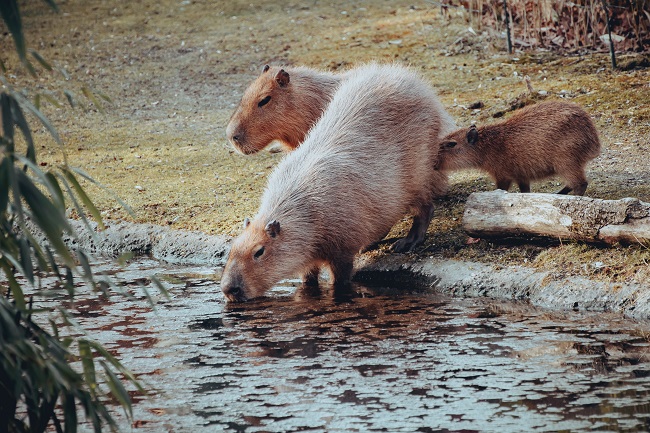
In the animal kingdom, some creatures captivate us with their unusual characteristics and lovable personalities. Among these fascinating creatures is the capybara, a unique rodent that holds the title of being the largest living rodent species in the world. Often referred to as the “gentle giants,” capybaras have gained popularity for their friendly nature, interesting behaviors, and undeniable charm.
Native to South America, capybaras can be found in various countries such as Brazil, Colombia, Venezuela, and Argentina. They are semi-aquatic mammals, perfectly adapted to a life near water. Capybaras are commonly found near rivers, lakes, and marshes, where they can indulge in their favorite pastime: swimming.
One of the most endearing qualities of capybaras is their social nature. They are highly gregarious animals, forming close-knit groups known as herds or communities. These communities often consist of multiple capybaras, ranging from a few individuals to as many as 100 members. Such social bonds are crucial to capybaras as they provide protection, companionship, and even assistance in raising offspring.
Capybaras are herbivorous creatures with a diet primarily consisting of grasses, aquatic plants, and fruits. Their unique dental structure allows them to graze on tough vegetation efficiently. Despite their large size, they are selective feeders, showing a preference for tender, nutritious plants.
Perhaps one of the most striking features of capybaras is their calm and docile nature. They have gained a reputation for their friendly disposition and remarkable tolerance towards other species, including humans. Capybaras are known to coexist harmoniously with other animals, often becoming an amusing sight as they share space with ducks, birds, and even crocodiles. Their peaceful demeanor has led to the term “capybara diplomacy” to describe their ability to mediate conflicts between different animal species. Capybaras are the gentle peacemakers, capable of calming tense situations and diffusing aggression in their environment.
Capybaras are highly social animals, and their interactions within their communities are a sight to behold. They engage in various behaviors, including vocalizations, grooming rituals, and even playful activities such as chasing and wrestling. These behaviors serve important roles in establishing and maintaining social bonds among herd members.
Another notable aspect of capybara behavior is their love for water. They are excellent swimmers and often take refuge in bodies of water to escape predators and to regulate their body temperature. Capybaras have partially webbed feet that aid them in navigating through water with ease. They are also capable of holding their breath almost five minutes, allowing them to stay submerged when necessary.
In recent years, capybaras have gained popularity beyond their native habitats. They have become beloved animal ambassadors in zoos and wildlife parks around the world, enchanting visitors with their charming appearances and amiable personalities. The rise of social media has also contributed to their fame, with countless adorable pictures and videos of capybaras capturing the hearts of internet users globally.
It is important to note that capybaras require specific habitats and care to thrive. In captivity, they need access to a pool or body of water for swimming and plenty of space to roam and graze. Due to their social nature, it is recommended to keep them in groups to ensure their well-being and provide them with the companionship they crave.
11 Fun Facts About Capybaras
World’s Largest Rodents
Capybaras hold the title for being the largest rodent in the world. Adults can reach an impressive size, typically ranging from 3 to 4.5 feet in length and weighing between 65 to 150 pounds.
Social Butterflies
They are highly social animals and live in large groups known as herds, bands, or communities. These groups can consist of 10 to 30 individuals, although larger gatherings of over 100 capybaras have also been observed.
Herbivorous Grazers
Capybaras are herbivores and have a diet primarily composed of grasses and aquatic plants. They also enjoy munching on fruits and bark. Their large incisor teeth and strong jaws allow them to graze efficiently.
Impressive Communicators
Capybaras communicate using various vocalizations, including purring, barking, whistling, and even clicking sounds. They also rely on scent marking and body language to convey messages within their social groups.
Excellent Divers
Capybaras can hold their breath for up to five minutes underwater. They can submerge themselves to escape from predators or to forage for aquatic plants.
Valuable Allies to Other Species
Capybaras are known for their harmonious relationships with other animals. They often share their habitat with birds, turtles, caimans, and other creatures, creating a unique ecological dynamic.
Chill and Easygoing
Capybaras have a reputation for being calm and docile animals. They are generally non-aggressive and display remarkable tolerance towards other species, including humans.
Coprophagy
Capybaras practice coprophagy, which means they eat their own feces. This behavior allows them to extract more nutrients from their food and aids in digestion.
Excellent Parents
Capybara females, called sows, are devoted mothers. They give birth to a litter that averages four to six young, called pups, and take great care of them. The entire social group often participates in protecting and caring for the newborns.
Highly Adaptive
Capybaras have adapted well to different habitats, including grasslands, swamps, rainforests, and even human-made environments such as agricultural areas and urban parks.
Protected Status
Capybaras are protected by law in many countries due to their ecological importance and vulnerability to habitat loss. They are listed as a species of least concern on the IUCN Red List of Threatened Species.
Related Articles & Free Email Newsletter Sign Up
Giant Salamanders are the Largest Amphibians in the World
The Badger is a Tenacious Guardian of the Ecosystem


Comment here